Information/Write-up
Gordon Lightfoot and Terry Whelan formed the duo (originally called The Two Timers) in 1960 and, looking to get a gig at the Mariposa Folk Festival (which was the big festival in all of North America at that time), were told by Estelle Klein (The "Queen Mum" of Canadian Folk Music and Artistic Director of the Mariposa Folk Festival) that they only booked artists that have record LP's", so they got a hold of Art Snider, picked up Howie Morris to play bass, grabbed a reel-to-reel tape recorder and recorded this album of mostly traditional folk tunes. And they did indeed get the gig at the Mariposa Folk Festival, playing as the Tu-Tones later in 1962!
Gordon Lightfoot's (born in Orillia, Ontario in 1938) legendary and iconic career has spanned six decades and is comprised of 21 original albums, which sold in excess of ten million copies. This recording was his first foray onto vinyl (he always said that he preferred live performances). It occurred on a cold stormy night on January 20th, 1962 after an ice storm, at The Village Corner, in Toronto, Ontario. Gordon Lightfoot was 24 years old and was partnered with his long time collaborator Terry Whelan (born Washago, Ontario). The Two Tones had 250 appearances on the CBC's Talent Caravan, While We're Young, and Country Hoedown between 1960 and 1963.
Two Tones also released two non-album 45's in 1962: 'Lessons in Love b/w Sweet Polly' on Quality 1395X and a rare spoken word advertisement 'Station Breaks b/w Safety Checks' on Quality Special 1-62. Hear the safety check tracks here: http://citizenfreak.com/titles/305081-two-tones-station-breaks-b-w-safety-checks
Later that year, Lightfoot recorded his first two solo 45's: 'Daisy-Doo b/w (Remember Me) I'm the One' on Chateau C 142 and 'Negotiations b/w It's Too Late, He Wins' on Chateau C 148.
The album features the earliest version of the song "This is My Song", which was later re-issued on "Early Lightfoot" on AME Records AME 7000 IN 1971.
-Robert Williston
From Lightfoot.ca:
Over the course of eight months in 1960, Lightfoot as a member of the Two Tones, undertakes four recording sessions at Newberry Sound Studio in Toronto. Newberry would go on to engineer the live Two Tones album in 1962.
January 11, 1960
Banjo Man (Les Pouliot)
But Not In My Heart
Lessons In Love (possibly same recording as Two Tones single?) (GL original)
Remember Me (I'm The One) (GL original)
Remember That I Love You
The Wanderer's Dream
Wondering
March 18, 1960
Dolly (GL original?)
Gone (GL original?)
I Found True Love At Home (GL original?)
Streets Of Laredo
The Day Is Here (GL original?)
This Is My Song (GL original)
Two Brothers
August 15, 1960
My Love For You (later recorded for Harry Tracy soundtrack in 1981) (Les Pouliot)
Sweet Polly (same recording as B-side of Two Tones single?) (Les Pouliot)
The Day Is Here (GL original?)
This Is My Song (GL original)
August 15, 1960
Echoes In My Heart
Gone (GL original?)
I Found True Love At Home (GL original?)
Please Take Me Back (GL original?)
Southwind (Les Pouliot)
Summer Love (Les Pouliot)
These liner notes to the Two Tones At The Village Corner album from 1962 and co-written by Lightfoot are remarkable in their description of the atmosphere surrounding one of his early club dates, a scene repeated many, many times thereafter as he was soon to go out solo, until he ultimately graduated to the concert stage.
Many of the traits that distinguish Lightfoot in his later career are in evidence even then, things such as respecting his audience and being aware of their impatience as the start is delayed. Lightfoot has always prided himself on being ready to play promptly at concert time. And like his countless concerts since that January night in 1962, he has continued to leave his audience wanting more...
TWO TONES AT THE VILLAGE CORNER - Liner Notes
To those who braved that stormy Saturday night of January 20, 1962 to attend the recording session of the Two Tones at the Village Corner, we dedicate this album.
Toronto was in the process of recovering from one of its famous ice storms, the night we recorded at the Village Corner. There was still ice on the telephone lines, with the gusty wind shaking bits of ice from the trees onto the heads of unsuspecting souls below. Despite the conditions, the after midnight crowd was there waiting for us.
Whoever thought up the name "Village Corner" wasn't far wrong. It is what used to be a house, about the size of a shoebox. Everyone was jammed in like matchwood, waiting for us to begin. It was so dark you could hardly see. The air was hot and sticky, the air conditioner wouldn't work but the coffee machine was working overtime. The smoke hung over everything like fog.
We were upstairs away from the smoke and noise waiting for Newberry to arrive, to begin recording. We could hear the din from downstairs, seeping up through the floorboards. The crowd was getting restless from the delay when we arrived.
We went down the narrow stairwell, which led to the club. We wormed our way through the smoke and crowded tables to the tiny stage at the end of the room. The mikes were all set up when we got to the stage and opened with "We Come Here To Sing". Through the haze we could see Newberry and Snider with head-sets on, twisting dials and watching needles like mad.
The rest of the session speaks for itself herein. The driving bass of Howie Morris was there at all times in the up-tempo stuff, and he played imaginatively throughout. Everyone was clapping and singing and having a ball. By the time we finished the last chorus of "Lord I'm So Weary" we really meant it, which is the way it should be.
They wanted more and we were glad, but we left them wanting.
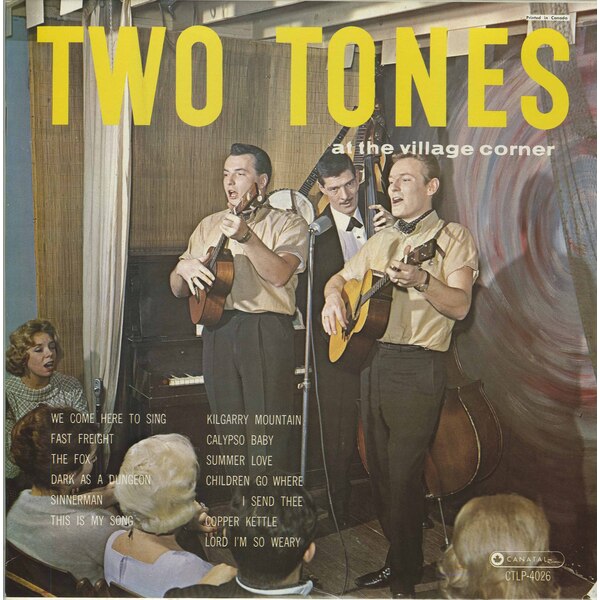
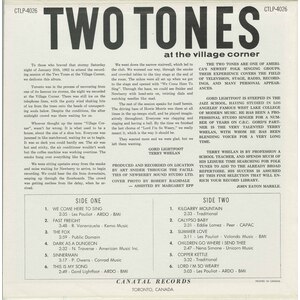
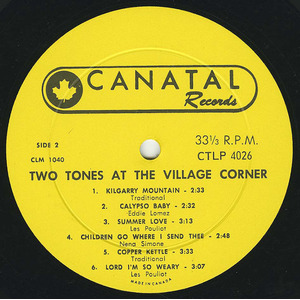
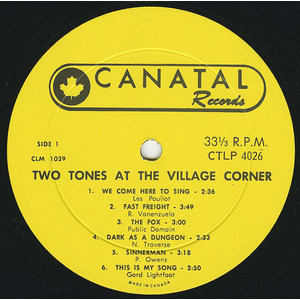
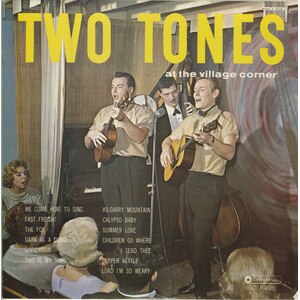
No Comments